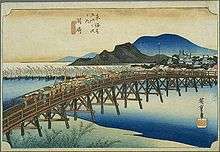Okazaki-shuku

Okazaki-shuku (岡崎宿 Okazaki-shuku) was the thirty-eighth of the fifty-three stations of the Tōkaidō. It is located in the present-day city of Okazaki, in Aichi Prefecture, Japan.
History
Okazaki-shuku was a part of the flourishing castle town surrounding Okazaki Castle, the headquarters for Okazaki Domain. The classic ukiyoe print by Ando Hiroshige (Hoeido edition) from 1831 to 1834 depicts a Yahagibashi, one of the few bridges permitted by the Tokugawa shogunate on the Tōkaidō, and one of the longest bridges built in Japan during the early Edo period. Okazaki Castle is depicted in the distance on the far shore of the river. [1] Following the Meiji restoration, with the construction of railroads, the route of what became the Tokaido Main Line was laid down through the nearby village of Hane (羽根村 Hane-mura) to the south. Unlike Goyu-shuku and Akasaka-juku, but this did not cause a huge economic decline to Okazaki-shuku. There was a horse-drawn rail line connecting Okazaki to the train station, as well as a teachers' school, which kept the town alive. On the other hand, Okazaki was not able to compete with the growth of Toyohashi, which was located directly on the railway, and which gained city-status first. Because of fires during World War II and the subsequent rebuilding of Okazaki in the post-war years, there are few remnants of the post town remaining today.
Neighboring post towns
- Tōkaidō
- Fujikawa-shuku - Okazaki-shuku - Chiryū-juku
- Shio no Michi's Sanshū Kaidō
- Kugyūdaira-juku - Okazaki-shuku (ending location)
Further reading
- Carey, Patrick. Rediscovering the Old Tokaido:In the Footsteps of Hiroshige. Global Books UK (2000). ISBN 1-901903-10-9
- Chiba, Reiko. Hiroshige's Tokaido in Prints and Poetry. Tuttle. (1982) ISBN 0-8048-0246-7
- Taganau, Jilly. The Tokaido Road: Travelling and Representation in Edo and Meiji Japan. RoutledgeCurzon (2004). ISBN 0-415-31091-1
References
![]() Media related to Okazaki-shuku at Wikimedia Commons
Media related to Okazaki-shuku at Wikimedia Commons